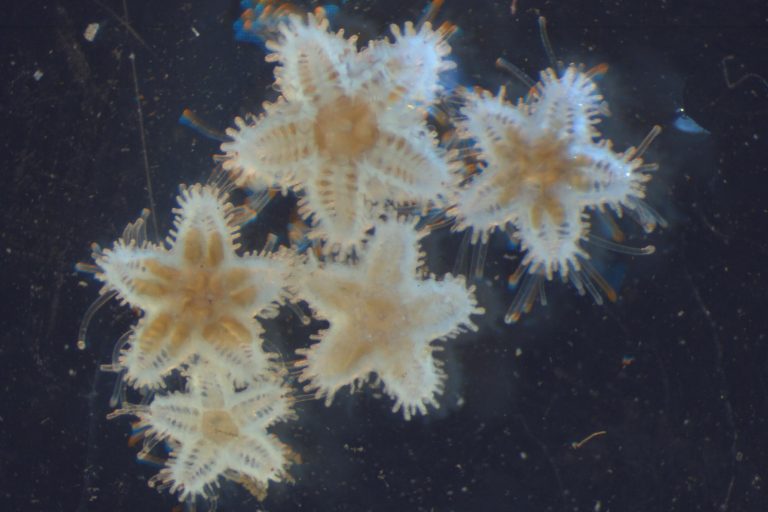26. September 2014
Sensitive youngsters
Young sea stars react more sensitively to ocean acidification than adults

Young sea stars from the Baltic Sea suffer more from the effects of ocean acidification than adults. In a laboratory experiment, scientists from GEOMAR Helmholtz Centre for Ocean Research Kiel showed that younger animals already eat less and grow more slowly at only slightly elevated carbon dioxide concentrations. Their results are now published in the journal “Marine Ecology Progress Series”.
Young individuals of a species are often more sensitive towards environmental stress than their adult counterparts. Scientists from GEOMAR Helmholtz Centre for Ocean Research Kiel now observed this effect in the sea star Asterias rubens from the Baltic Sea. In a long-term laboratory experiment that was conducted in the framework of the German research network BIOACID (Biological Impacts of Ocean Acidification), the researchers simulated three different levels of acidification that could be reached in the Baltic Sea by the uptake of additional carbon dioxide (CO2) within the coming decades. The results showed that even at slightly increased acidification, the small sea stars grew more slowly and ate less. “In adult sea stars, we only observed this effect at significantly higher carbon dioxide concentrations in the water”, Dr. Jörn Thomsen explains. Thomsen is one of the two first authors of the long-term study that has been described in the journal “Marine Ecology Progress Series”. It was observed that the animals could not adapt to the acidified conditions even after a very long acclimation period.
The sea star Asterias rubens is one of the most important benthic species is in the Western Baltic. As important predators, they keep the mussel population under control. “If the sea stars suffer from the effects of ocean acidification, it could affect the entire ecosystem in the long run”, concludes Dr. Yasmin Appelhans, the other first author of the new study. “For example, only a few sea stars live in the Bay of Lübeck, because of the low salinity there. The mussels in this region can spread unhindered and outcompete other species.”
It is not yet fully understood why the majority of the young sea stars develop poorly under elevated CO2 conditions in the laboratory. However, the study showed that the sea stars did not store less calcium carbonate in their skeletons under acidification. “They might grow less because they need more energy to form calcium carbonate”, Thomsen assumes. “The fact that they eat less might also indicate that the acidic water affects the digestive enzymes.”
A few individuals grew well even under a high CO2. Appelhans: “If these tolerant animals succeed, sea stars could possibly adjust to new environmental conditions. For some species, there are already indications that an adaptation by evolution is possible. Whether this also applies to the sea stars should be investigated in the future. At the same time, it is important verify the observations from the lab under more natural conditions.”
Original publication:
Appelhans, Y.S., Thomsen, J., Opitz, S., Pansch, C., Melzner, F., Wahl, M. (2014): Juvenile sea stars exposed to acidification decrease feeding and growth with no acclimation potential. Mar. Ecol. Prog. Ser., 509, 227-239, doi: 10.3354/meps10884